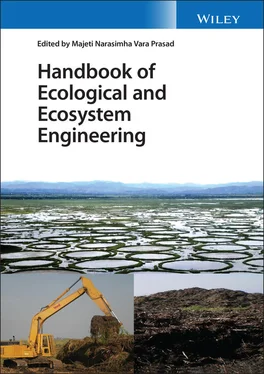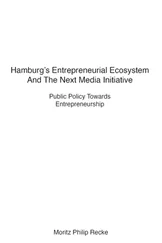Ecological engineering envisages the practice of engineering methods and designs for ecological sciences, bridging these two disciplines with the interpretation of complex, uncertain, and variable natural systems. This approach can result in a unique archetype for designing engineering methods. Human beings are integral components of the ecosystem, providing the initial elements and composition and influencing the environment significantly. The self‐organizing ecosystem eventually takes over these changes and looks for the best route to adjust to artificial modulations imposed on it.
The approach of ecological engineering can be briefly summarized as (i) improvement of new or existing infrastructure with modern complex building models but using environmentally benign materials and ecofriendly designs, referred to as a “hard” approach 2 ; (ii) incorporation of a “soft” approach, i.e. the replacement of buildings and infrastructure with natural habitats such as salt marshes, mangroves, or oyster reefs; (iii) designing hybrid ecological engineering where natural habitats or vegetation are made to coexist with built infrastructure[10]. The approach of ecological engineering may differ with the environment, geographic locations, resources, requirements etc., but the common goal of all the approaches is to restore the natural habitats with the best possible infrastructural design for the benefit of the environment with the progress of development.
The field of ecological engineering has developed immensely within the research and academic dimensions to achieve higher endeavors for environmental sustainability and mankind. Several essential steps are proposed by researchers as part of ecological engineering activities [2, 31, 33, 35, 50, 60]:
Propose principles.
Design processes and techniques.
Implement the techniques.
Organize research archives.
Create international societies.
Include ecological engineering in academic curricula.
Proposing principles is considered the most significant step as the foundation of ecological engineering will be established upon it. These principles must connect ecological theory with ecological practices on real ground, which has been a challenge to researchers for years. The primary principles of ecological engineering proposed by Ma [28] were designed to formulate species symbiosis, cycling, and regeneration, and harmonize the ecological structure with its function. Later, 12 commandants or guidelines were formulated as principles of ecological engineering [17]:
1 Ecosystem structure and functions are determined by the forcing functions of the system.
2 Homeostasis of ecosystems requires accordance between biological function and chemical composition.
3 It is necessary in environmental management to match recycling pathways and rates to ecosystems to reduce the effect of pollution.
4 Ecosystems are self‐designing systems. The more one works with the self‐designing ability of Nature, the lower the cost of the energy to maintain that system.
5 Processes of ecosystems have characteristic time and space scales that should be accounted for in environmental management.
6 Chemical and biological diversity contribute to the spectrum of buffering capacities and the self‐designing ability of ecosystems.
7 Ecotones (transition zones) are as important for ecosystems as membranes are for cells.
8 The coupling between ecosystems should be utilized to the benefit of the ecosystems in the application of ecotechnology and in environmental management of agricultural systems.
9 The components of an ecosystem are interconnected and interrelated and form a network, which implies that direct as well as indirect effects are important.
10 It is essential to realize that an ecosystem has a history when applying ecotechnology and environmental management in general.
11 Ecosystems are most vulnerable at their geographical edges.
12 Ecosystems are hierarchical systems, and all the components forming the various levels of the hierarchy make up a structure that is important for the function of the ecosystem.
Based on these principles, a few ecotechnology rules can be derived for proper management of the environment and ecosystem. These rules are summarized in Table 3.1. The terms ecological engineering and ecotechnology are used interchangeably, although the former defines the creation and restoration of the ecosystem, while the latter describes ecosystem management.
3.2 Basic Concepts of Ecological Engineering
In addition to the 12 principles, some basic concepts of ecological engineering are involved in solving environmental issues. The following concepts thus individually or collectively explain the benefits with an engineering approach:
1 It is based on the self‐designing capacity of the ecosystem.
2 It can be used as an acid test of ecological theories.
3 It depends on system approaches.
4 It conserves non‐renewable sources of energy.
5 It supports biological conservation.
Table 3.1 Rules of ecotechnology.
| Rule no. |
Rule |
Brief explanation |
| 1) |
Minimize energy waste. |
Limit fossil energy utilization, thus reducing global warming; find new energy sources with promising efficiency. |
| 2) |
Recycle. |
Recycle and reuse materials, synthetic or natural; reduce environmental degradation. |
| 3) |
Retain all kinds of structures. |
Natural structures and biodiversity persevere. |
| 4) |
Consider long‐term horizons. |
Sustainable life will be realized with long‐time evaluations. |
| 5) |
Do not forget that humankind is dependent on many organisms and that their loss may lessen our ability to survive in the changing environment. |
Continuously replace food sources and medications. |
| 6) |
Consider economic dynamics. |
Incorporate dynamic ecosystem models in conventional practices. |
| 7) |
Nature is a teaching ground for handling complex systems. In particular, the ability to survive by adapting to changing conditions can be learned only from Nature. |
The preparation of new technological models should be adopted from principles of Nature and based on adapting to continuous change in the environment. |
| 8) |
People, as part of the ecosystem, are directly dependent on solar energy and indirectly dependent on energy stored in coal and oil as well as vegetable and animal food. |
The need for energy for growth and reproduction is inevitable: we are dependent on the environment. |
| 9) |
People are sensitive to external inputs, particularly solar radiation and the supply of minerals from the earth. |
Environmental impacts can be both beneficial and detrimental. Extraction and use of minerals from the earth's crust is for human welfare, while exposure to harmful UV radiation is the root cause of diseases such as cancer. |
| 10) |
Manage the environment as an interconnected system, not as isolated subsystems. |
Every great discovery made by humans has come with a price to be paid by the environment sooner or later. A systematic and detailed investigation must be carried out with products having multi‐mediated feedbacks so that negative environmental impacts can be minimized. |
| 11) |
Evaluate the available management options simultaneously. |
The various routes for solving environmental issues must be thoroughly investigated and assessed. |
| 12) |
Include secondary effects elsewhere. |
A global system of evaluation is necessary to evaluate the output measures of environmental management practices. |
| 13) |
Do not exceed the ecosystem's homeostatic (assimilation) capacity. |
The environment should not be deteriorated to a level from which it cannot recover or be restored to its original state. |
| 14 |
Consider ecosystem self‐adaptation to management strategies. |
Resistance to chemical treatment by organisms (flies, parasites, super‐bugs) is a well‐known problem. Introducing new species (plants or animals) to a region can be helpful. However, the new species' ability to adapt to the environment must be considered. |
| 15 |
Evaluate the socioeconomic environment. |
Economic welfare bodies and environmentalists should work together to achieve common goals. |
| 16 |
Evaluate all possible human uses of the environment. |
While designing a model or project, one must consider the maximum utilization of environmental resources with as little impact as possible. |
| 17 |
Base measures on ecosystem principles. |
Ecosystem principles play a vital role in the successful launch of environmental management models. |
These concepts have been discussed in detail by Mitsch and Jørgensen [34]. Further, four philosophical Aristotelian causes have been suggested by Ulanowicz [58, 59] to argue the change‐causing activities of engineering, as follows:
Читать дальше












